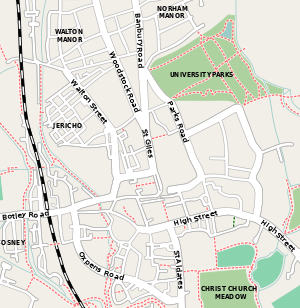Bridge of Sighs (Oxford)
| Hertford Bridge | |
|---|---|
 Hertford Bridge from Catte Street | |
 Location within Oxford city centre | |
| Alternative names | Bridge of Sighs |
| General information | |
| Type | Covered bridge |
| Location | Hertford College, Oxford |
| Coordinates | 51°45′16″N 1°15′14″W / 51.75447°N 1.25389°W |
| Completed | 1914 |
| Design and construction | |
| Architect | Thomas Graham Jackson |
Hertford Bridge, often called "the Bridge of Sighs", is a skyway joining two parts of Hertford College over New College Lane in Oxford, England. Its distinctive design makes it a city landmark.
Misnomer and myth
The bridge is often referred to as the Bridge of Sighs because of its supposed similarity to the famous Bridge of Sighs in Venice. However, Hertford Bridge was never intended to be a replica of the Venetian bridge, and instead it bears a closer resemblance to the Rialto Bridge in the same city.
There is a false legend saying that many decades ago, a survey of the health of students was taken, and as Hertford College's students were the heaviest, the college closed off the bridge to force them to take the stairs, giving them extra exercise. However, if the bridge is not used, the students actually climb fewer stairs than if they do use the bridge.[1]
Building
The bridge links together the Old and New Quadrangles of Hertford College (to the south and the north respectively), and much of its current architecture was designed by Sir Thomas Jackson. It was completed in 1914, despite its construction being opposed by New College.
The building on the southern side of the bridge houses the College's administrative offices, whereas the northern building is mostly student accommodation. The bridge is always open to members of the College, who can often be seen crossing it.


See also
- Bridge of Sighs, Venice
- Bridge of Sighs, Cambridge
- Logic Lane covered bridge, at University College, Oxford
References
External links
| Wikimedia Commons has media related to Bridge of Sighs (Oxford). |
- Photograph and short history on OxfordCityGuide.com
- Photograph from Daily Information
- Bridge of Sighs at Structurae